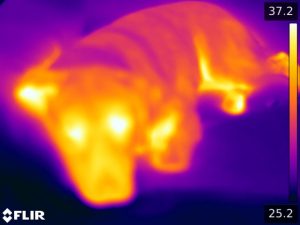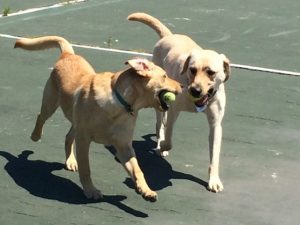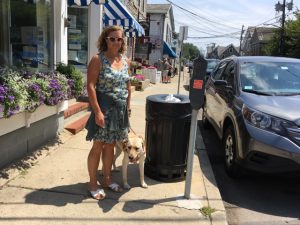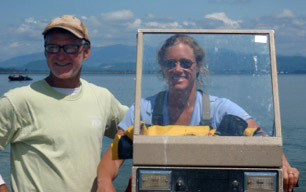Our Seeing Eye instructors contacted us on Thursday for a two-week progress report: Hugger got an A.
She acclimated quickly to her new places, at home and in the office. She seems thrilled to explore, and my staff and students were thrilled to give us new destinations to find in Falmouth, such as the french bakery and Coffee Obsession …. (of course, I had to return with treats as evidence of our success, smile).
We received a demonstration of a fancy infrared camera that a colleague might use to observe surfzone eddies this fall. Not sure yet whether it will work for our science needs, but Hugger is a hot dog!
She had a play date with a friend’s pup, who taught Hugger how to play keep away. But after we threw a 2nd ball onto the courts, Hugger taught Sandy to play fetch!
I clicker-trained Hugger to find the garbage can near the picnic table where we eat lunch. She found the trash quickly the next day. Then we left for a week of travel to the west coast …
She got antsy after an hour in the plane – she had flown once before, and knew it was an hour-long event! But she settled down when she figured out that some flights were longer than Newark-to-Boston. We got to know all of terminal 2 in Salt Lake City, searching for the dog relief area, which had been moved owing to construction. And wow was she zipping thru the crowds. NYC was nothing compared with concourse B! After a little bone-chewing and fetch in our hotel room, she slept quietly next to the bed. On the return flight, she remembered where to go for the SLC relief area (Gate B13), and had figured out the plane routine (curl up and enjoy the sleep time), or maybe she was just jet-lagged.
And … when we returned to WHOI today, a week after clicker-training, Hugger found the trash can without any hesitation. I have to start training her to find empty seats, and to generalize to other trash cans. We have a week to work on these goals at WHOI, then off to North Carolina for field work.





